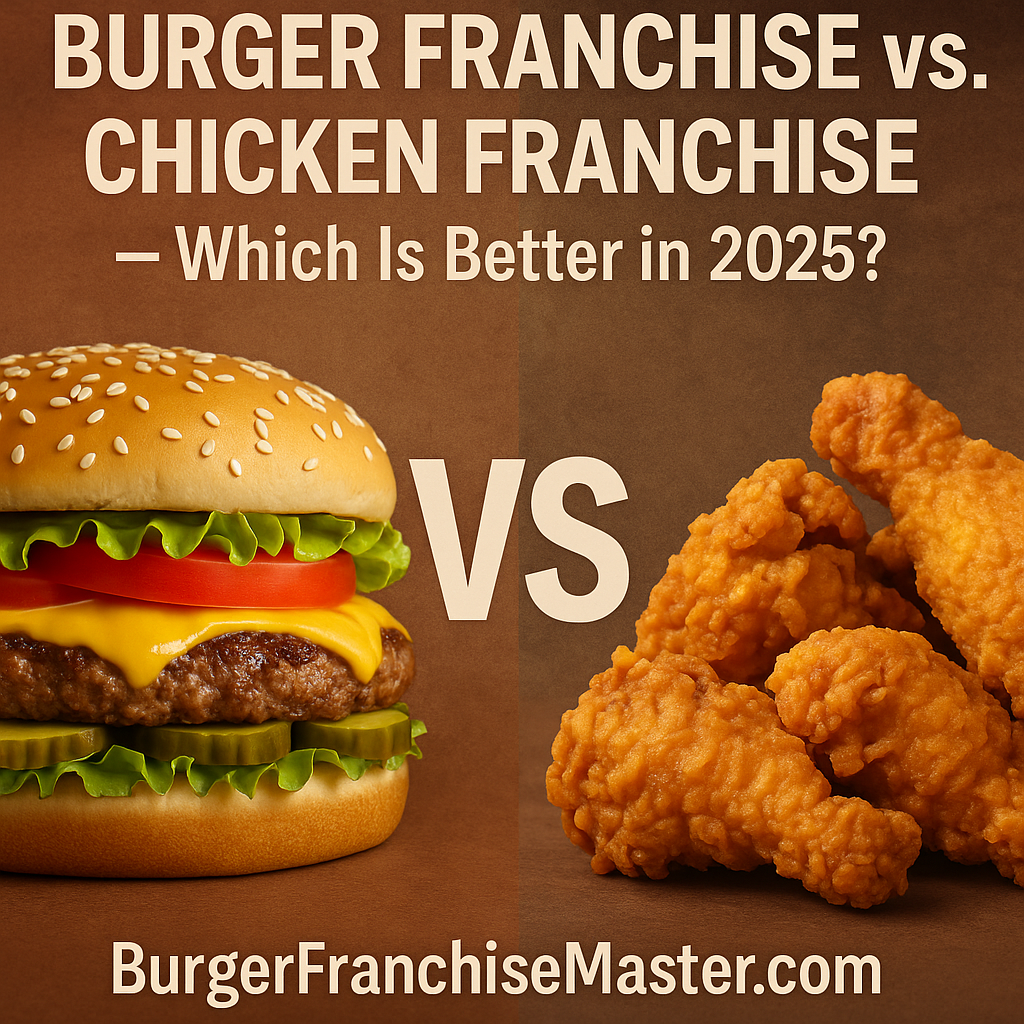
As the fast-food industry continues to grow and evolve, two categories remain at the top of investor interest: burger franchises and chicken franchises. But if you’re considering buying into one, you may be asking: Which is the better investment opportunity in 2025?
At BurgerFranchiseMaster.com, we’ve worked with dozens of entrepreneurs and brands across both sectors. Here’s a side-by-side breakdown to help you decide which food franchise concept fits your goals, budget, and market best.
🔍 Market Demand
🍔 Burgers:
- Universally loved across all age groups
- Flexibility in protein options: beef, plant-based, chicken, even seafood
- Great for lunch, dinner, and late-night service
- Strong global appeal with consistent demand
🍗 Chicken:
- Surging global popularity due to perceived health benefits
- Chicken sandwiches and wings are trending, especially with Gen Z
- High versatility (grilled, fried, spicy, boneless)
- Easier to localize with regional flavors
✅ Winner: Tie — both have strong, growing demand. Chicken has the edge in emerging health-conscious markets, but burgers remain a staple in urban and youth-driven zones.
💸 Startup Costs
🍔 Burger Franchise:
- Wide range of investment options — from under $200K (food trucks) to $1M+ (multi-unit fast casual)
- Equipment like grills and fryers are standard
- Established supply chains = cost stability
🍗 Chicken Franchise:
- Similar startup range, though deep-frying equipment and ventilation can increase costs
- Some major chicken brands (e.g., Chick-fil-A, Popeyes) have longer waitlists and selective entry
- High oil consumption increases operational costs
✅ Winner: Burger — more low-cost options and flexibility for smaller footprints like kiosks or ghost kitchens.
🔧 Operations & Menu Management
🍔 Burgers:
- Straightforward assembly line production
- Easier to offer customization without slowing prep
- Simpler storage and fewer allergens than poultry
🍗 Chicken:
- Requires strict handling due to food safety (raw poultry)
- More oil, more cleanup, and more labor-intensive prep
- Higher margin for spicy/boneless wings and loaded chicken meals
✅ Winner: Burger — easier to manage operationally, especially for new franchisees.
🌟 Brand Differentiation
🍔 Burger:
- High competition, but also high opportunity to stand out via branding (e.g., smash-style, plant-based, gourmet)
- More room to innovate with sauces, buns, toppings
🍗 Chicken:
- Hot market but saturated with similar spicy fried concepts
- Trending formats include tenders-only shops and chicken & biscuit pairings
✅ Winner: Burger — stronger potential for unique positioning, especially in premium and vegan niches.
🧮 Profit Margins
Margins vary by brand, but here’s a general guide:
| Concept | Avg. Gross Margin | Notes |
|---|---|---|
| 🍔 Burger | 60–65% | Consistent ingredient costs, upsell potential with fries & shakes |
| 🍗 Chicken | 55–60% | Slightly higher food costs due to poultry and oil waste |
✅ Winner: Burger – Slightly better margins and upselling power (combos, drinks, desserts).
🌍 Global Scalability
Both concepts scale well globally, but…
- Burger franchises tend to perform better in international markets due to universal appeal
- Chicken brands perform best in regions with a strong fried food culture (e.g., Southern U.S., West Africa, Philippines)
✅ Winner: Burger – more franchise flexibility worldwide, especially in multicultural urban markets.
🧠 Final Verdict: Why Burger Franchises Win in 2025
While both burger and chicken franchises are profitable and growing, burger franchises remain more versatile, scalable, and beginner-friendly — especially for investors seeking lower startup costs, operational simplicity, and global flexibility.
💼 Need Help Choosing the Right Burger Franchise?
At BurgerFranchiseMaster.com, we help franchise investors like you compare brand costs, regional opportunities, and long-term potential — and we’re backed by the experts at Star Brands Consulting Group.
👉 Request a Free Franchise Match Report
👉 Download Our Free Burger Business Guide

Leave a Reply